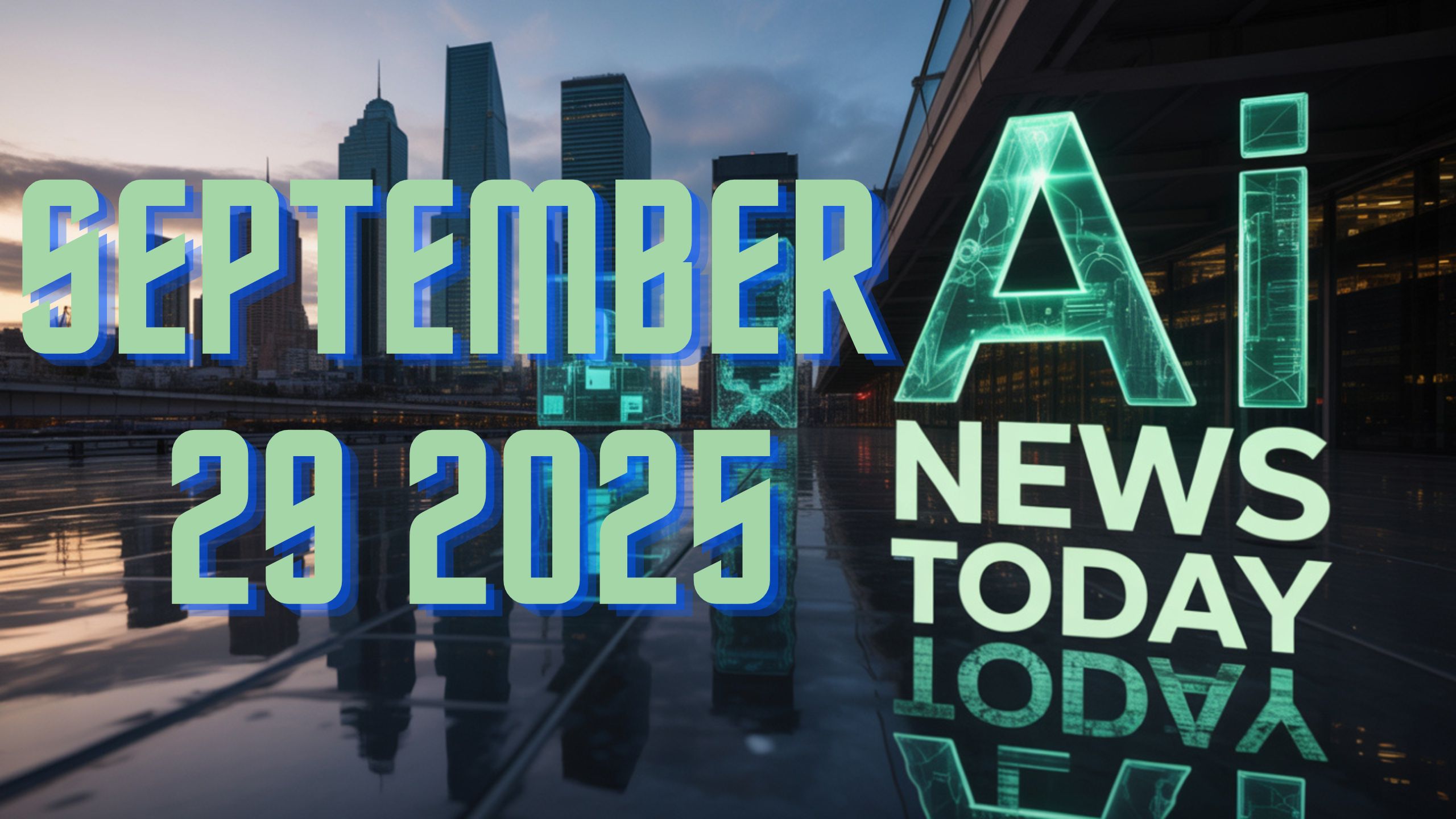AI News Daily — USA (Monday, September 29, 2025)– The landscape of artificial intelligence in the United States is evolving rapidly, with new developments shaping regulation, infrastructure, and adoption at both state and federal levels. On September 29, 2025, the conversation spans from mental-health chatbot oversight to the financing challenges of Stargate’s massive data-centre expansion, raising important questions about sustainability, accountability, and global competition. States such as Illinois and Nevada are cracking down on AI “therapy” apps, while the FDA prepares an advisory panel to evaluate generative-AI mental-health devices. At the same time, corporate giants like Walmart are investing in AI workforce training, and leaders in the semiconductor industry warn of narrowing gaps with China. Together, these threads define America’s AI strategy heading into Q4 2025.
States Advance Mental-Health Chatbot Regulations Amid Federal Oversight
The spotlight on AI-powered mental-health chatbots continues to intensify in the United States. Following the Federal Trade Commission’s 6(b) orders targeting youth-facing AI therapy platforms, several states have begun drafting or enforcing their digital therapy and companion apps rules.
- Illinois and Nevada have already implemented strict bans on AI apps claiming to provide medical or therapeutic treatment.
- Other states are expected to introduce mandatory disclosure requirements, ensuring users know when interacting with AI rather than licensed professionals.
- Suicide-risk monitoring may become compulsory in multiple jurisdictions, reflecting heightened concern about vulnerable populations relying on these tools.
In addition, the Food and Drug Administration (FDA) has announced it will convene an advisory panel on generative-AI mental-health devices on November 6, 2025, signalling federal readiness to treat AI mental-health platforms as regulated medical technologies.
This marks a pivotal moment where state initiatives and federal oversight converge, shaping the future of AI in healthcare and mental wellness.
Stargate Expansion Faces Financing and Feasibility Concerns
The ambitious Stargate data-centre initiative, spearheaded by OpenAI, Oracle, and SoftBank, continues to draw scrutiny as details emerge about its funding structure. New reports emphasize that much of the program relies on:
- Debt financing
- Vendor-backed chip purchases
- Aggressive infrastructure build-outs scheduled between 2026 and 2028
Market analysts warn that this financing model could expose Stargate to delivery risks and cost overruns, especially if AI market revenues fail to keep pace with infrastructure expansion. With multiple new sites announced across the U.S., questions remain about whether capital availability and partnership dynamics can sustain the scale of investment required.
The concern is not about ambition but execution risk—whether the consortium can bridge the gap between bold vision and practical financial feasibility.
AI Investment: Bubble or Backbone of the Economy?
The surge in AI capital expenditure has reignited comparisons to the dot-com bubble of the late 1990s. Wall Street analysts note that data-center spending is breaking historical records, driving valuations of AI-linked companies to unprecedented highs.
- Some banks warn that AI may be propping up weak U.S. economic growth.
- Projections suggest a potential $800 billion revenue shortfall by 2030 if monetization of AI technology lags behind the massive infrastructure investments being made today.
This debate centers on whether the AI boom represents a sustainable backbone of future growth or a speculative bubble that could destabilize markets if expectations outpace real adoption and profitability.
Walmart Leads in AI Workforce Upskilling
One of the clearest indicators of enterprise AI adoption comes from Walmart, which has unveiled a comprehensive AI skills program for its U.S. workforce in partnership with OpenAI.
The initiative includes:
- AI training modules integrated into employee development tracks
- Performance benchmarks that evaluate proficiency in using AI tools across functions
- Collaboration with academic institutions to ensure workers gain transferable skills
Walmart’s move signals a broader shift in corporate America, where AI literacy is becoming essential for specialized roles and frontline and managerial staff alike. Major employers position AI skills as core competencies in hiring, training, and promotion strategies.
This could begin a nationwide workforce transformation, with companies embedding AI fluency into employee development.
Nvidia and the AI Chip Competition
In a high-profile statement, Nvidia’s CEO asserted that China is only “nanoseconds behind” the U.S. in AI chip innovation. This remark has sharpened the export-control and supply-chain narrative dominating U.S. policy discussions.
The U.S. infrastructure push is not only about capacity but also about maintaining technological leadership in semiconductors. Policymakers are now framing AI investment around the concept of “exporting the AI stack” to allied nations, reinforcing U.S. dominance in:
- High-performance computing chips
- Generative AI software ecosystems
- Data-center infrastructure models
This positioning underscores the geopolitical stakes of AI competition and chip supremacy in shaping domestic and international AI strategies.
The Administration’s AI Action Plan
At the federal level, the AI Action Plan continues to serve as the strategic blueprint for U.S. AI development. Key pillars include:
- Accelerating domestic infrastructure build-outs
- Expanding national AI skills programs
- Relying on voluntary industry standards rather than imposing rigid regulations
- Promoting an exportable U.S. “AI stack” as both a commercial and geopolitical tool
By aligning with private sector initiatives such as Stargate, the Action Plan reflects a dual strategy: build capacity at home while extending U.S. influence abroad through technological standards and partnerships.
Key Threads Shaping Q4 AI Strategy
The convergence of these developments paints a clear picture of the AI policy and market landscape heading into Q4 2025. Several interlinked themes dominate:
- Youth-safety oversight and regulation of AI mental-health tools
- Financial feasibility and execution risks in mega-projects like Stargate
- Macroeconomic sustainability of record-high AI capital expenditure
- Workforce transformation through AI skills training
- Chip competition and U.S. export-driven policy frameworks
Each thread underscores the complexity of the current AI ecosystem, where innovation, policy, finance, and workforce readiness must align to sustain long-term growth.
Wrap Up
As the United States moves into the final quarter of 2025, the trajectory of AI policy, financing, and adoption will be defined by how effectively regulators, corporations, and governments can balance innovation with accountability. The mental-health chatbot debate, the Stargate financing model, and the macro-economic sustainability of AI capex will test the resilience of both private enterprise and public institutions.
Simultaneously, the global chip race and workforce AI upskilling programs demonstrate that AI is not merely a technological issue but a societal transformation in progress. The months ahead will determine whether AI becomes the backbone of future growth or a speculative bubble vulnerable to collapse.
AITeam is the dedicated editorial team of Android Infotech, consisting of experts and enthusiasts specialized in Android-related topics, including app development, software updates, and the latest tech trends. With a passion for technology and years of experience, our team aims to provide accurate, insightful, and up-to-date information to help developers, tech enthusiasts, and readers stay ahead in the Android ecosystem.
For more about our team, visit our About Us page.




Leave a Reply